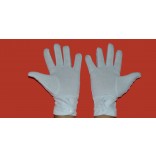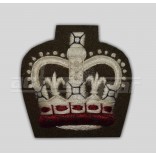Details
Pace sticks are an “aid to drill” and may be carried by WOs and NCOs during the conduct of, evaluation of, and in preparation for drill lessons, practices.
The Royal Regiment of Artillery (United Kingdom) lays claim to being the originator of the Pace Stick. It was used by Field Gun Teams to ensure correct distances between the guns on the battlefield, thus ensuring the appropriate effective fire. The original Pace Stick was more like a walking stick with a silver or ivory knob. It could not be manipulated in a similar manner to the modern Pace Stick as it opened just like a pair of callipers. It’s a common view that the infantry developed the Pace Stick to its present configuration as an aid to drill. It is usually carried by warrant officers, non-commissioned officer drill instructors in the British and Commonwealth Armed Forces and police forces as a symbol of authority while on the drill square.
A pace stick usually consists of two pieces of wood, hinged at the top, and tapering towards the bottom. Usually shod and fitted with highly-polished brass, the overall length of the pace stick can range from 36 inches up to 44 inches as this depends on your choice of length. They can open so that the tips separate at fixed distances, corresponding to various lengths of marching pace, such as "double march", "quick march", "step short", etc. On the pace stick there is a measuring bar catch and locking catch that secures the stick at a desired setting or opening. However, different pace sticks manufactured do not all have the same setting. Some pace sticks have settings of 12, 21, 24, 27, 30, 33, 40 inches while some have settings of 12, 21, 24, 30, 33, 40 inches. In the closed position the thumb screw locks the legs together in the bottom catch. When opened to the correct pace length, the pace stick can be held alongside the holder's body by the hinge, with one leg of the stick vertical to the ground, and the other leg pointing forward. Hinge is re-enforced with steel pins for better stability and reliability all feet are fitted with steel tips. All sticks are made finished to a high durable gloss and brass fittings are polished to a mirror finish. Engraved plates can added to the outside or inside of the stick which manufacturers charge an additional charge to do. There is also Pace Stick cane which can come with a gold/nickel plated head and ferrule in brown/skin/black color and high finishing multi silk cord on the stick.
The pace stick comes in black, medium oak, dark oak, light oak and rose wood. Pace sticks are humidity resistant and long lasting. In some regiments it’s common to distinguish appointments and ranks by the colour of your pace stick, the darker the wood colour, the more senior the rank. Following on this principle, the RSM tends to carry a pace stick with a colour very close to black.
By twirling the stick while marching, the stick can be made to "walk" alongside its holder at the proper pace. Otherwise, while on parade or when marching it is closed and normally carried tucked tightly under the left arm and parallel to the ground, with the left hand grasping the stick near the top
From the beginning the infantry used the pace stick as a drill aid. In 1928 Arthur Brand M.V.O. M.B.E. developed the drills for the pace stick. The stick he used is still carried by the Academy Sergeant Major at the Royal Military Academy, Sandhurst. This competition was held annually between Royal Military Academy Sandhurst and the Guards Depot. It was originally four Sergeants in the team and a Warrant Officer as the team captain who acted as the driver and gave the words of command over the course which involved marching in slow and quick time whilst alternating turning the stick with the left or right hand. The teams are now modified to a frontage of three Sergeants but the driver still remains a Warrant Officer. Since the closing of the Guards Depot in April 1993 the annual competition has demised, however the All Arms (World Championships) pace sticking competition still carries on and is held annually at Royal Military Academy Sandhurst. Teams from all over the world compete in different categories for the title of World Champion Pace-Sticking team or the prestigious individual World Pace-Stick Champion. The objective of the pace stick drill is to provide uniformity in the use of the stick and a high standard of steadiness and cohesion amongst the instructors. The stick is used to determine the correct length of the pace, distance between the ranks and to check drill movement. The instructor marches with the stick open next to the squad. By using the stick he can check the length of the pace, and then lengthen or shorten the pace. The Racer Pace Stick is the pace stick that is used for this competition because of its slimness and light weight.
Pace sticks can be opened to specific distances, which each measure specific things:
12" Distance between heels when at ease, and regulation side pace
21" Distance between ranks when stood in closed order
24" Distance between files, also width of one 'man' when leaving a blank file
27" Stepping short, inside rank when wheeling
30" Regulation pace for quick and slow march
33" Stepping out, outside rank when wheeling
40" Regulation pace for double time
As the current use is primarily as an aid to drill, it is unusual to see a Warrant Officer or Senior NCO carrying a pace stick while not on the parade square. The pace stick is usually permitted to be carried off the parade ground by the Regimental Sergeant Major alone; however, at a particular regiment's discretion, other sergeants-major may carry a pace stick. The pace stick can be carried horizontally under the left armpit. It is to be held firmly at the point of balance between the upper arm and the body (with the point of the stick to the rear and the brasses uppermost), and the stick gripped between the thumb and fingers of the left hand, back of the hand outwards, fingers and thumb straight. The right arm is to remain straight at the side.
The correct size is obtained by whilst standing to attention, measuring the distance in inches, from the bottom of the heel of the boot, to the top of the waistband of the belt (might be an idea to get someone to help you do this).
Additional Information
| size | No |
|---|
You may also be interested in the following product(s)
-

Shoulder Sashes
$49.99 -

White Parade Gloves
$5.00 -

Badge of Rank- Worsted Warrant Officer Class II
$14.99





